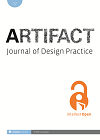-
oa Biodiversity Logbooks: Design for noticing nature at a hyperlocal scale
- Source: Artifact, Volume 9, Issue 1-2, Dec 2022, p. 24.1 - 24.21
-
- 20 Feb 2022
- 21 Sep 2022
- 23 Jan 2023
Abstract
This article considers the pedagogical importance of noticing nature at the hyperlocal scale, and the role that design can play in nurturing and supporting these processes. Biodiversity Logbooks are a set of educational resources that promote direct engagement with everyday environments through a variety of creative methods, including cyanotype photography, physical computing, collaborative mapping and journaling. These tools are intended to be used in combination to develop skills of noticing plants in their habitats and understanding how different environments support different life forms. This article argues that while complex environmental phenomena are often addressed at the global scale (with local impacts presented as scalable outcomes), focusing on small, often overlooked details can have beneficial pedagogical outcomes. These consist of increased attentiveness and care for the needs of other species, better retention of knowledge generated through embodied experience and stronger connection with place. In the article, the impacts of the project as described by the teachers who participated in the experience are discussed in connection to broader epistemological issues. These include plant blindness as a widespread phenomenon in urban populations, and the importance of observing messy entanglements and non-scalable dynamics when building knowledge about the environment.
Funding
- Lancaster University through their ESRC Impact Accelerator Account



